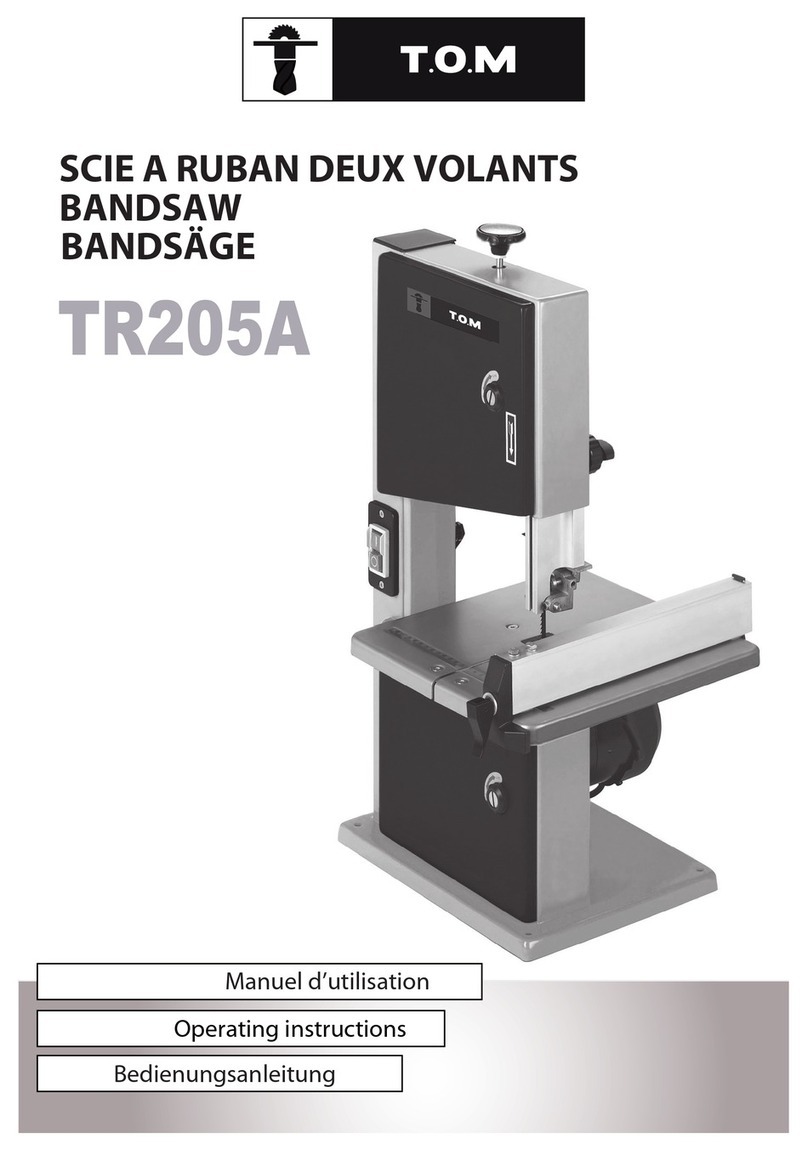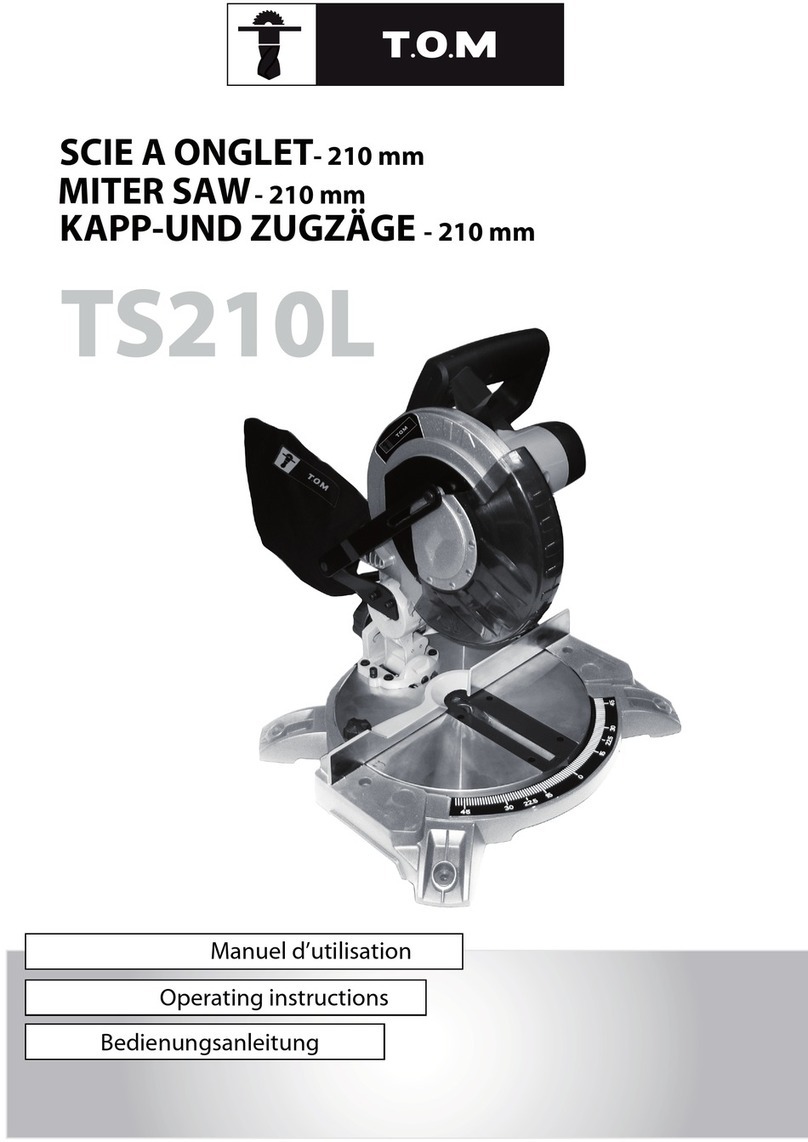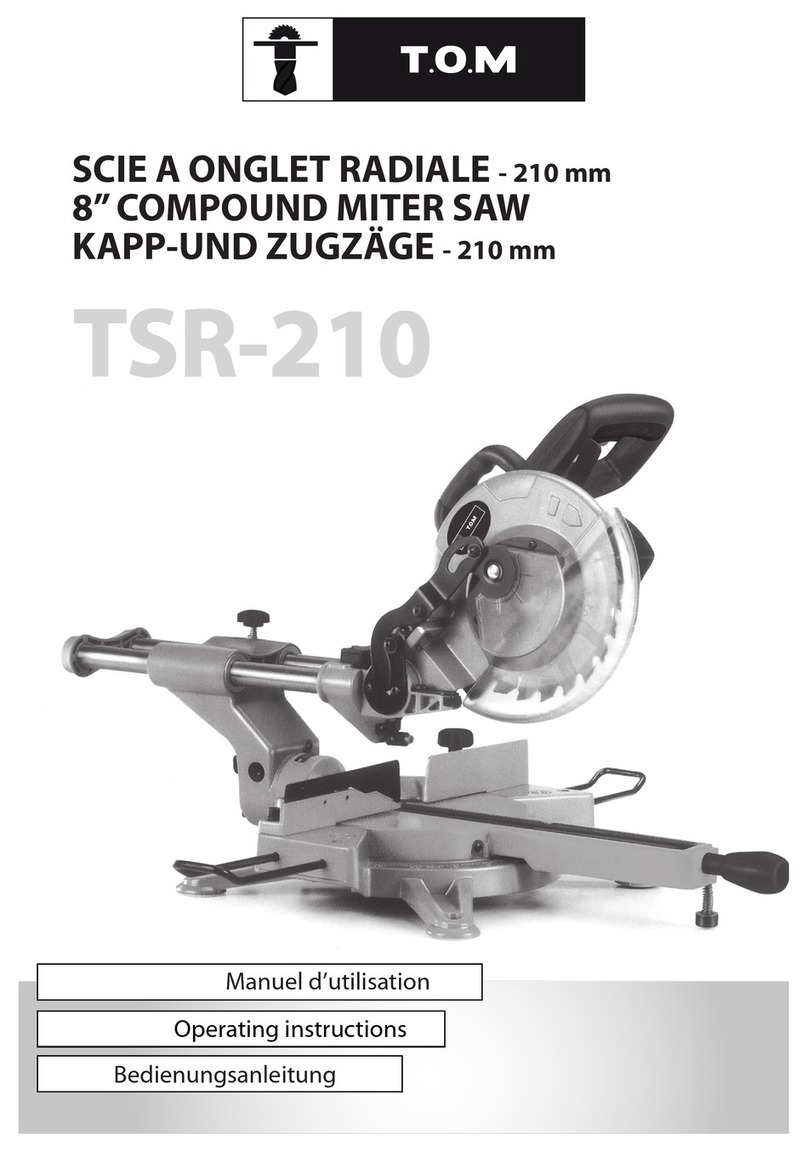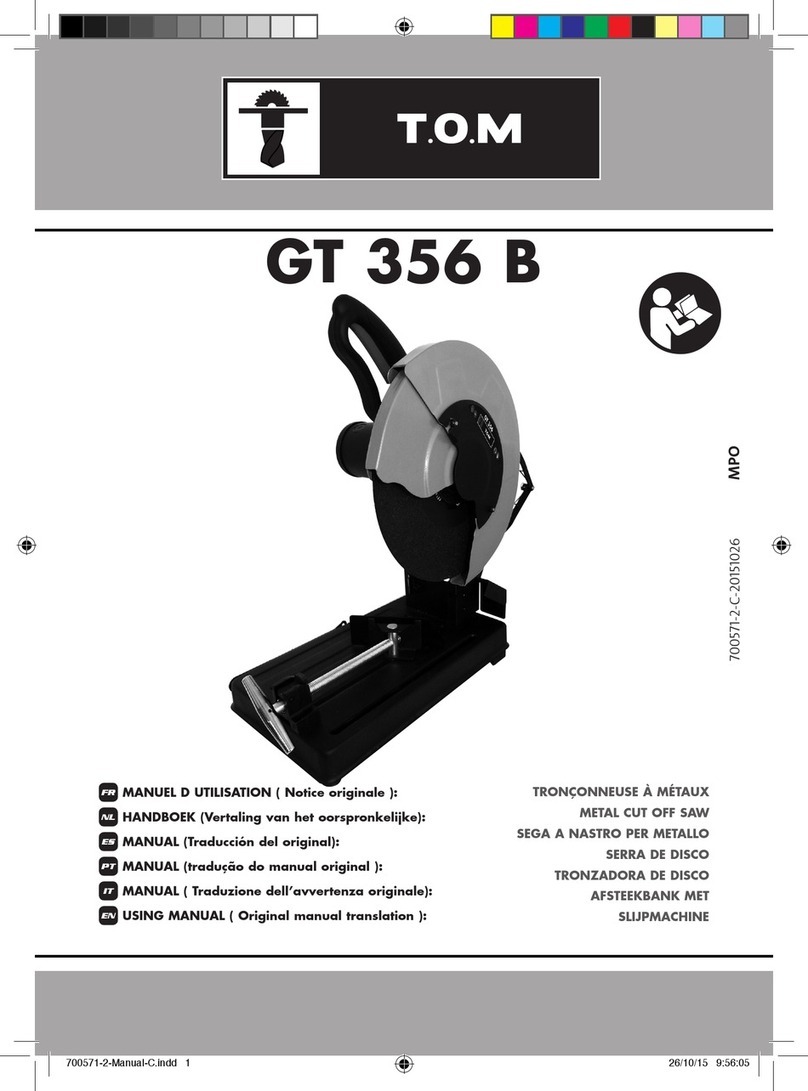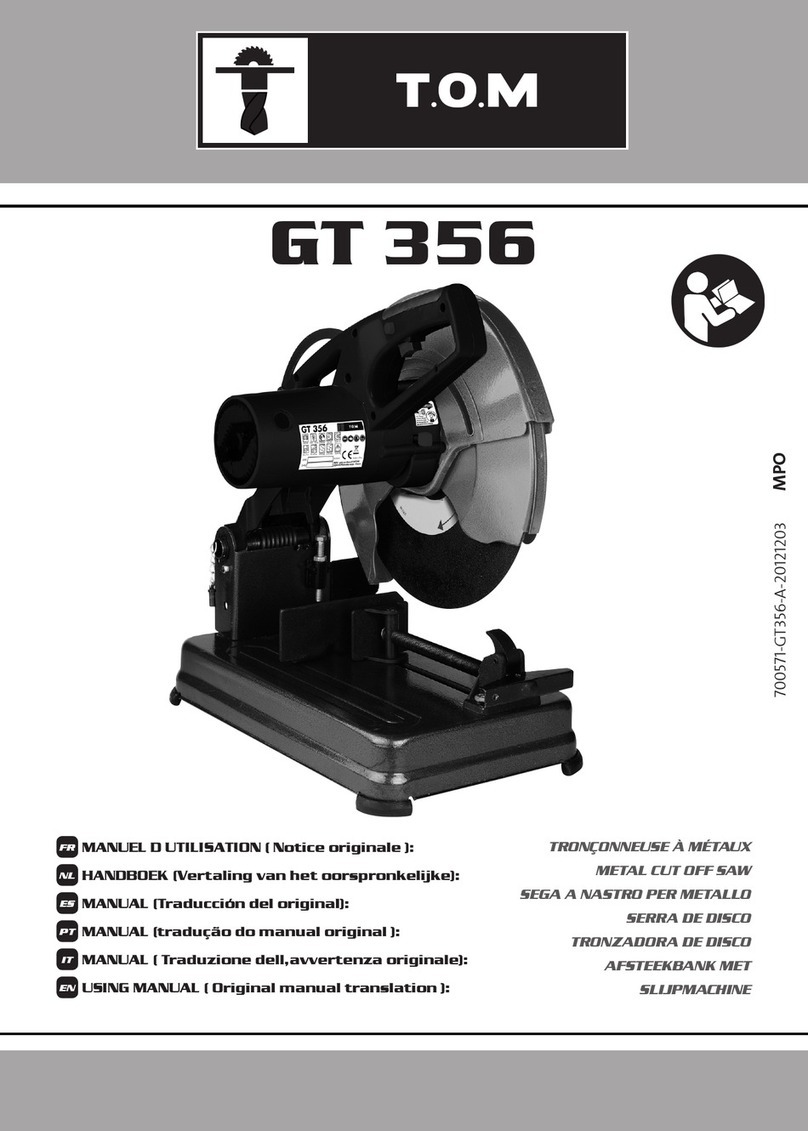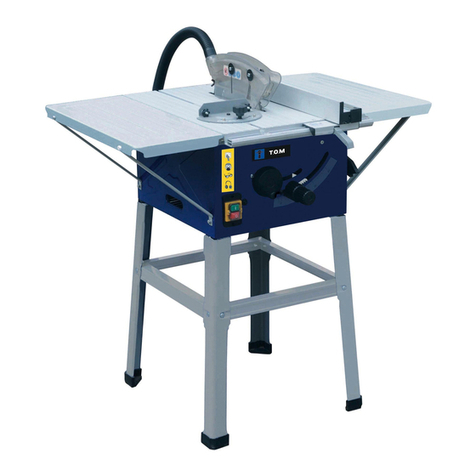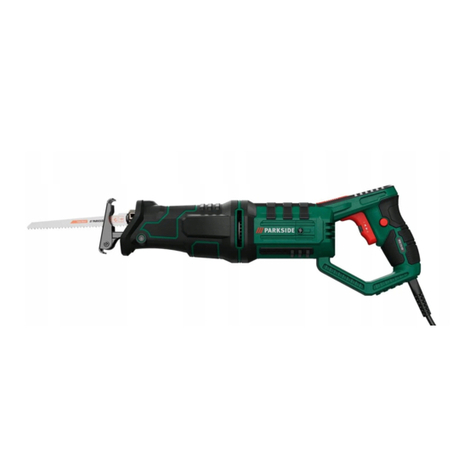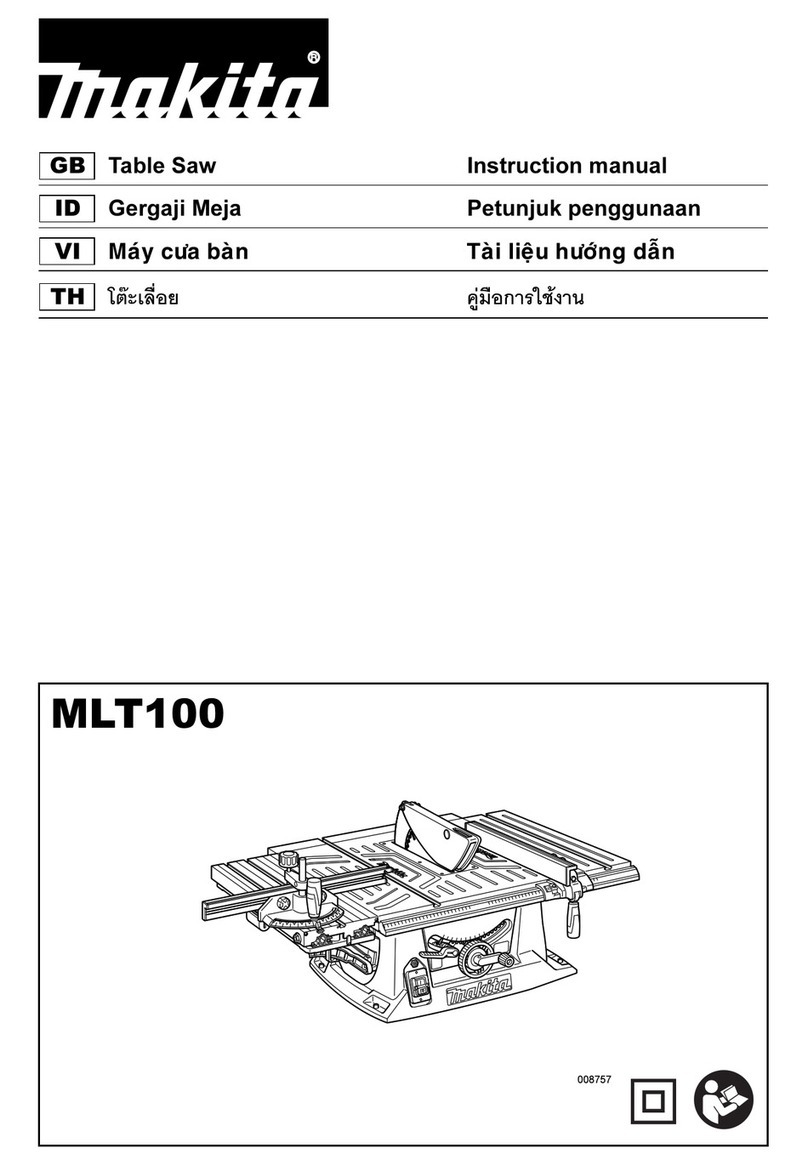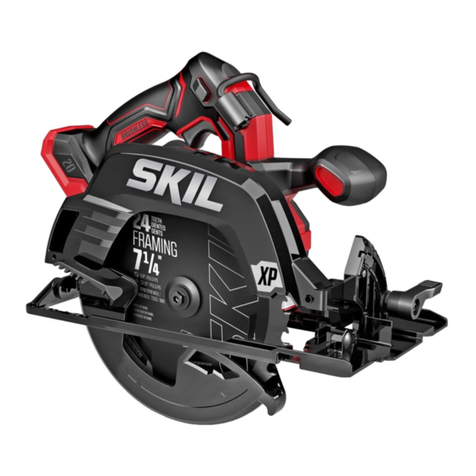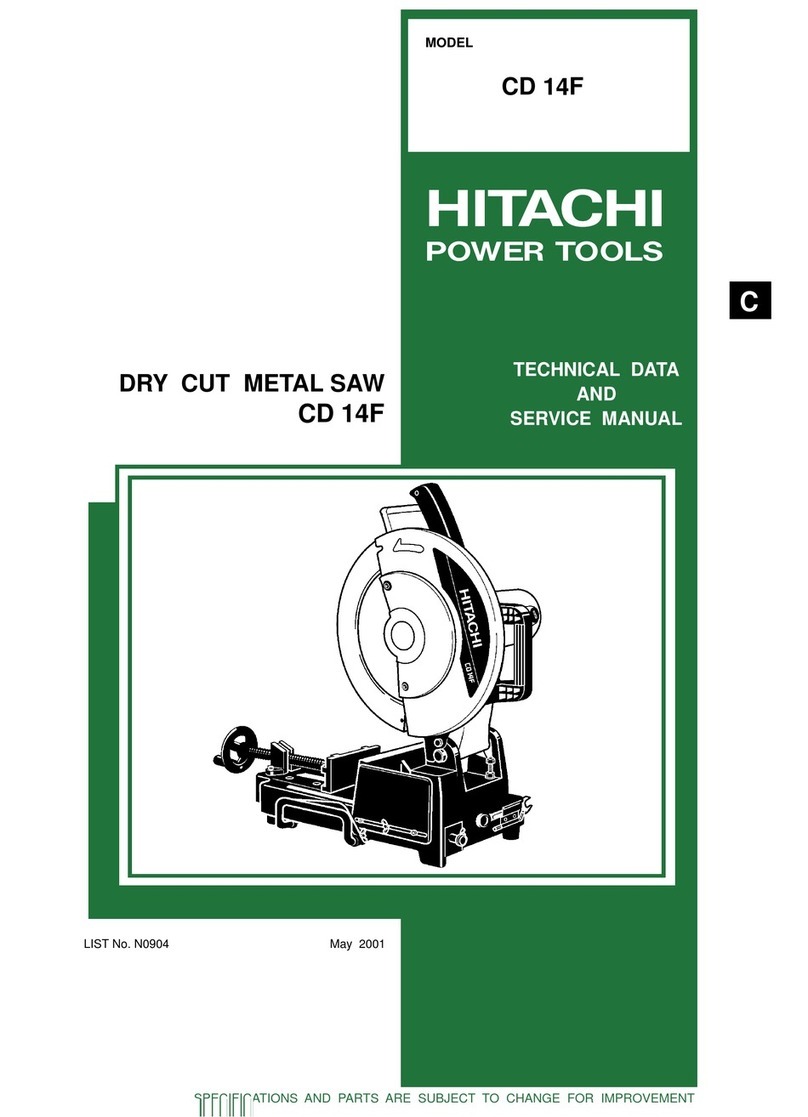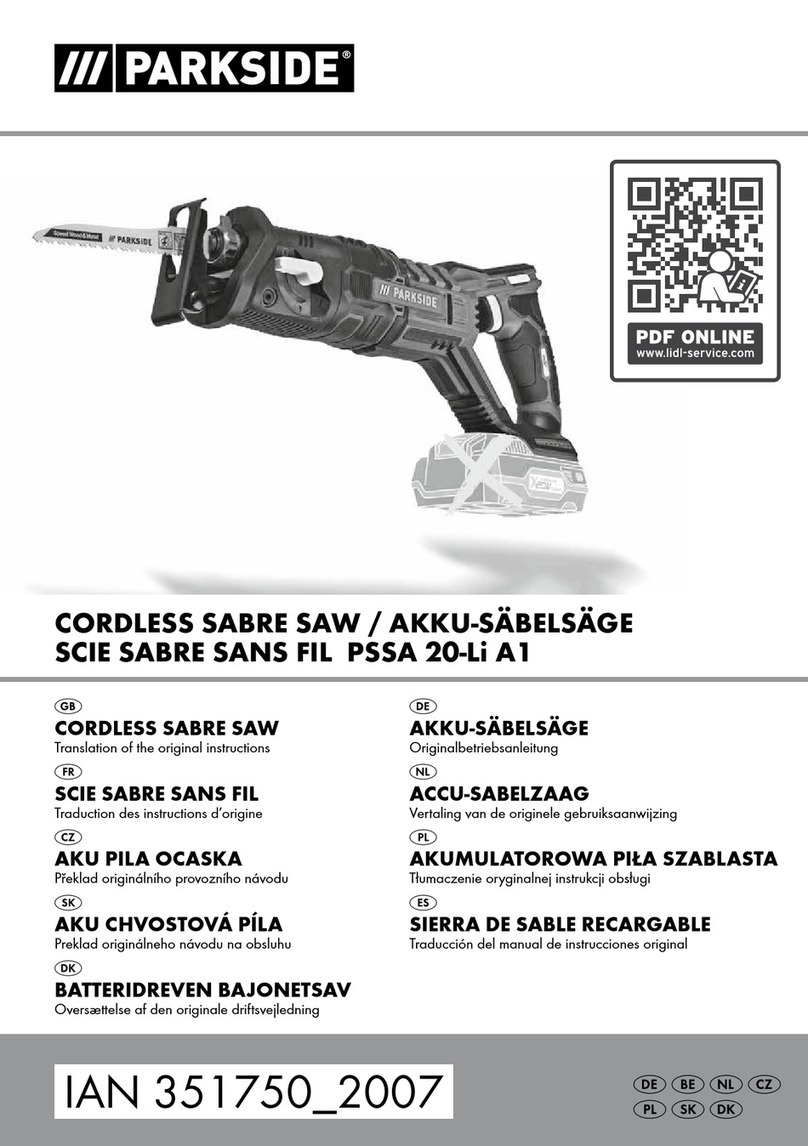T.O.M GSS13V Installation and operating instructions

SCIE A CHANTOURNER
SCROLL SAW
DEKUPIERSÄGE
Manuel d’utilisation
Operating instructions
Bedienungsanleitung
GSS13V
Scie à chantourner à variateur
Scroll Saw with variable Speed
Figuurzaagmachine
700606-C-20141125 mpo
GSS13V
Pantone 2728 C
2 colors version
TOM brand - Color Chart
Black 100%
Technical fence
C 95 M 70
CYMK version
K 100
K 60
Grey scale version
K 100
K 0
Outlined black version
K 100
K 0
1 color version
K 100
Technical fence
Technical fence
700606-Manual-C.indd 1 31/08/15 11:28:23

700606-Manual-C.indd 2 31/08/15 11:28:23

3
SOMMAIRE
FRANÇAIS
---------------------------------------------------------------------------------------------------------------------------
PROTECTION POUR L’ENVIRONNEMENT
-----------------------------------------------------------------------------
4
CONSIGNES DE SECURITE -------------------------------------------------------------------------------------
5
CONSIGNES SPECIFIQUES AUX SCIES A CHANTOURNER ---------------------------------------
6
ASSEMBLAGE ET SPECIFICATIONS -----------------------------------------------------------------------
7
MONTAGE ------------------------------------------------------------------------------------------------------------ 8
UTILISATION DE LA MACHINE -------------------------------------------------------------------------------- 9
REGLAGE DE COUPE -----------------------------------------------------------------------------------------
10
ENTRETIEN -------------------------------------------------------------------------------------------------------
11
LISTE DES PIÈCES ---------------------------------------------------------------------------------------------
30
VUE ÉCLATÉE ----------------------------------------------------------------------------------------------------
31
CONFORMITÉ ET GARANTIE -------------------------------------------------------------------------------
32
ENGLISH
----------------------------------------------------------------------------------------------------------------------------------
GENERAL SAFETY RULES
-----------------------------------------------------------------------------------------------------
14
ADDITIONAL SAFETY RULES FOR TABLE SAW
-----------------------------------------------------------------
14
SYMBOLS
--------------------------------------------------------------------------------------------------------------------------------
15
INSTALLATION
-------------------------------------------------------------------------------------------------------------------------
15
PRODUCT SPECIFICATIONS
-------------------------------------------------------------------------------------------------
15
ASSEMBLY AND ADJUSTMENTS
------------------------------------------------------------------------------------------
16
SETTING THE TOOL
----------------------------------------------------------------------------------------------------------------
18
CONNECTING TO THE POWER SUPPLY
-----------------------------------------------------------------------------
19
OPERATION THE TOOL
----------------------------------------------------------------------------------------------------------
20
CHANGING BLADES
----------------------------------------------------------------------------------------------------------------
21
RECYCLABLE MATERIALS ANALYSIS LIST
-------------------------------------------------------------------------
33
TSR-210 PARTS LIST
--------------------------------------------------------------------------------------------------------------
33
TSR-210 MOTOR PARTS LIST
-----------------------------------------------------------------------------------------------
36
TSR-210 STAND PARTS LIST
--------------------------------------------------------------------------------------------------
38
CONFORMITY AND WARRANTY
-------------------------------------------------------------------------------------------
43
DEUTSCH
-------------------------------------------------------------------------------------------------------------------------------
ALLGEMEINE SICHERHEITSREGELN
-----------------------------------------------------------------------------------------
23
ZUSÄTZLICHE SICHERHEITSREGELN FÜR TISCHKREISSÄGEN
----------------------------------------------------
24
SYMBOLE
------------------------------------------------------------------------------------------------------------------------------
25
INSTALLATION
-----------------------------------------------------------------------------------------------------------------------
25
SPEZIFIKATIONEN
------------------------------------------------------------------------------------------------------------------
25
MONTAGE
-----------------------------------------------------------------------------------------------------------------------------
26
EINRICHTEN DES WERKZEUGS
-----------------------------------------------------------------------------------------------
28
ANSCHLUßAN DIE STROMQUELLE
-----------------------------------------------------------------------------------------
29
INBETRIEBNAHME DES GERÄTE
----------------------------------------------------------------------------------------------
30
SÄGEBLATTWECHSEL
-------------------------------------------------------------------------------------------------------------
31
LISTE FÜR RECYCLEBARE MATERIALIEN
-----------------------------------------------------------------------------------
32
TEILELISTE TSR-210
-----------------------------------------------------------------------------------------------------------------
33
MOTORTEILE LISTE TSR-210
----------------------------------------------------------------------------------------------------
36
STÜCKLISTE DER BASIS TSR-210
----------------------------------------------------------------------------------------------
38
KONFORMITÄTSERKLÄRUNG AND GARANTIEKARTE
----------------------------------------------------------------
43
ATTENTION
Une utilisation incorrecte et dangereuse de cet outil motorisé peut entraîner la mort ou
des blessures graves.
Lisez l’intégralité du manuel d’utilisation avant de faire fonctionner votre outil.
CONSERVEZ CES INSTRUCTIONS POUR UNE CONSULTATION ULTÉRIEURE.
Y
MANUEL D’UTILISATION
700606-Manual-C.indd 3 31/08/15 11:28:23

Le symbole de la poubelle sur roues barrée d’une croix signifie que ce produit doit faire l’objet d’une collecte sélective en fin
de vie au sein de l’Union européenne. Cette mesure s’applique non seulement à votre appareil mais également à toute autre
accessoire marqué de ce symbole. Ne pas jeter ces produits dans les ordures ménagères non sujettes au tri sélectif.
En application de la directive DEEE concernant l’environnement, il est interdit d’éliminer des appareils électriques ou électro-
niques usagés dans la nature ou dans une simple décharge publique.
L’appareil doit être remis à un point de collecte approprié pour le traitement, la valorisation, le recyclage des déchets EEE ou
rapporté chez son distributeur sur le principe du 1 pour 1 (soit un appareil acheté contre un appareil repris).
L’utilisateur fait ainsi un geste pour l’environnement, et contribue à la préservation des ressources naturelles et à la protection
de la santé humaine.
CORDONS PROLONGATEURS
1¶XWLOLVH]TXHGHVFRUGRQVSURORQJDWHXUVjWURLVFRQGXFWHXUVSRVVpGDQWXQH¿FKHjGHX[EURFKHVHWGHVSULVHVjGHX[FDYLWpVHWXQHWHUUHFRU-
UHVSRQGDQWjOD¿FKHGHO¶RXWLO/RUVTXHYRXVXWLOLVH]XQRXWLOpOHFWULTXHjXQHGLVWDQFHLPSRUWDQWHGHO¶DOLPHQWDWLRQDVVXUH]YRXVG¶XWLOLVHUXQ
FRUGRQSURORQJDWHXUTXLDXQHGLPHQVLRQVXI¿VDQWHSRXUWUDQVSRUWHUOHFRXUDQWGRQWO¶RXWLODEHVRLQ8QFRUGRQSURORQJDWHXUVRXVGLPHQVLRQQp
provoquera une chute de tension dans la ligne conduisant à une surchauffe et à une perte de puissance. Utilisez le tableau pour déterminer la
GLPHQVLRQPLQLPDOHGHV¿OVUHTXLVHGDQVXQFRUGRQSURORQJDWHXU6HXOVGHVFRUGRQVSURORQJDWHXUVURQGVFRPSRUWDQWXQUHYrWHPHQW¿JXUDQW
sur la liste établie par les laboratoires peuvent être utilisés.
Longueur du cordon prolongateur : jusqu’à 15 m
'LPHQVLRQGX¿O[PP2
$YDQWG¶XWLOLVHUWRXWFRUGRQSURORQJDWHXUYpUL¿H]TX¶LOQHFRPSRUWHSDVGH¿OVTXLGpSDVVHQWRXVRQWQXVHWTXHO¶LVRODQWQ¶HVWSDVFRXSpRX
usé. Réparez ou remplacez immédiatement un cordon endommagé ou usé.
RACCORDEMENT ELECTRIQUE
Votre machine comporte un moteur électrique fabriqué avec précision. Elle doit être branchée sur une alimentation de 230 V, 50 Hz. Si votre
DSSDUHLOQHIRQFWLRQQHSDVORUVTX¶LOHVWEUDQFKpGDQVXQHSULVHYpUL¿H]ELHQOHVFDUDFWpULVWLTXHVGHO¶DOLPHQWDWLRQ
Le niveau de bruit de la machine est mesuré selon la norme DIN EN ISO 3744 : 1995-11 ; DIN EN ISO 11203 : 1996-07.
Les valeurs citées sont des valeurs d’émission calculées selon les normes en vigueur et non des valeurs liées à l’utilisation sur le lieu de tra-
vail. Bien qu’il y ait une corrélation entre ces différents niveaux d’émission, il est impossible de tirer une
TXHOFRQTXHFRQFOXVLRQVXUGHVSUpFDXWLRQVVXSSOpPHQWDLUHVjDSSRUWHU'HVIDFWHXUVD\DQWXQHLQÀXHQFHSRWHQWLHOOHVXUOHQLYHDXG¶pPLVVLRQ
sonore sur le lieu de travail incluent la durée de travail, la taille de la pièce ainsi que les autres sources de bruit (ex : le nombre de machines
en fonctionnement, autres opérations bruyantes effectuées en même temps). Les seuils de niveau sonore varient d’un pays à l’autre. Pour ces
différentes raisons, nous recommandons aux utilisateurs de porter un casque de protection auditif lors de l’utilisation de cette machine.
Niveau de pression acoustique maximal : 79.3 dB(A) - Niveau de puissance acoustique maximal : 92.3 dB(A)
Incertitude K : 3 dB
/DPLVHjODWHUUHFRQVLVWHjUHOLHUjXQHSULVHGHWHUUHSDUXQ¿OFRQGXFWHXUOHV
masses métalliques qui risquent d’être mises accidentellement en contact avec le
courant par suite d’un défaut d’isolement dans un appareil électrique. Cette mise à
la terre, associée à un disjoncteur différentiel, évite tout incident. Le courant passe
directement dans la terre et l’alimentation est automatiquement coupée.
1HPRGL¿H]SDVOD¿FKHIRXUQLH6LHOOHQHUHQWUHSDVGDQVODSULVHIDLWHVLQVWDOOHU
XQHSULVHDSSURSULpHSDUXQpOHFWULFLHQTXDOL¿p
Un raccordement mal fait du conducteur de mise à la terre de l’équipement peut
entraîner un risque de décharge électrique. Le conducteur dont la gaine isolante
HVWYHUWHDYHFXQ¿OHWMDXQHHVWOHFRQGXFWHXUGHPLVHjODWHUUH6LODUpSDUDWLRQ
ou le remplacement du cordon d’alimentation est nécessaire, ne raccordez pas le
conducteur de terre à une borne sous tension.
5HQVHLJQH]YRXVDXSUqVG¶XQpOHFWULFLHQTXDOL¿pRXG¶XQHSHUVRQQHUHVSRQVDEOHGHO¶HQWUHWLHQVLOHVLQVWUXFWLRQVGHPLVHjODWHUUHQHVRQWSDV
complètement comprises ou s’il y a un doute quant à la mise à la terre correcte de l’outil.
6LOHFkEOHG¶DOLPHQWDWLRQHVWHQGRPPDJpLOGRLWrWUHUHPSODFpSDUOHIDEULFDQWVRQVHUYLFHDSUqVYHQWHRXGHVSHUVRQQHVGHTXDOL¿FDWLRQ
VLPLODLUHD¿QG¶pYLWHUXQGDQJHU1HSDVIDLUHIRQFWLRQQHUO¶RXWLODYHFXQFkEOHG¶DOLPHQWDWLRQHQGRPPDJp
Cet outil est prévu pour être utilisé sur un circuit comportant une prise murale. Il est aussi doté d’une broche de mise à la terre.
PROTECTION DE L’ENVIRONNEMENT
BRANCHEMENT DE LA MACHINE - RACCORDEMENTS ELECTRIQUES
INFORMATION SUR LE BRUIT
INSTRUCTIONS DE MISE A LATERRE
4
700606-Manual-C.indd 4 31/08/15 11:28:24

AVERTISSEMENT : lire le manuel dans son intégralité. Le non
respect des instructions énumérées ci-après peut résulter en un
choc électrique, un incendie ou de graves blessures. Le terme « outil
pOHFWULTXHª¿JXUDQWGDQVWRXVOHVDYHUWLVVHPHQWVpQXPpUpVFLDSUqV
renvoie aussi bien à l’outil électrique lorsqu’il est raccordé au secteur
(via le cordon d’alimentation) que lorsqu’il fonctionne sur batterie
(sans câble). CONSERVEZ CES INSTRUCTIONS.
1) Zone de travail
a) La zone de travail doit être propre et bien éclairée. Les zones
encombrées et sombres peuvent favoriser les accidents. b) Il ne faut
pas utiliser les outils électriques dans des atmosphères explosives,
HQSUpVHQFHGHOLTXLGHVLQÀDPPDEOHVGHJD]RXGHSRXVVLqUH/HV
RXWLOVpOHFWULTXHVJpQqUHQWGHVpWLQFHOOHVTXLSHXYHQWHQÀDPPHUOD
poussière ou les fumées.
c) Éloignez spectateurs et enfants de la zone de travail lors de l’utili-
sation d’un outil électrique. Toute distraction peut vous faire perdre le
contrôle de l’outil.
2) Sécurité électrique
D/D¿FKHGHO¶RXWLOpOHFWULTXHGRLWFRUUHVSRQGUHjODSULVHPXUDOH,O
QHIDXWHQDXFXQFDVPRGL¿HUOD¿FKH1¶XWLOLVH]SDVGH¿FKHG¶DGDS-
tation avec des outils électriques devant être reliés à la terre (masse).
/HV¿FKHVG¶RULJLQHHWOHVSULVHVPXUDOHVDGDSWpHVUpGXLVHQWOHV
risques de choc électrique.
b) Évitez les contacts corporels avec les surfaces reliées à la terre
telles que tuyauteries, radiateurs, réfrigérateurs et autres. Le risque
de choc électrique est accru dès lors que votre propre corps est relié
à la terre ou à une masse.
c) Il ne faut pas exposer les outils électriques à la pluie ou à l’humi-
dité. La pénétration d’eau dans un outil électrique augmente le risque
de choc électrique.
d) Ne malmenez pas le cordon électrique. Ne transportez, tirez ou dé-
branchez jamais l’outil électrique en tirant sur le cordon. Éloignez ce
dernier des sources de chaleur, des matières graisseuses, des arêtes
tranchantes et des pièces en mouvement. Les cordons endommagés
ou enchevêtrés augmentent le risque de choc électrique.
H3UpYR\H]XQSURORQJDWHXUVSpFL¿TXHSRXUXVDJHH[WpULHXUSRXU
utiliser l’outil électrique à l’extérieur.
L’utilisation d’un cordon pour usage extérieur réduit les risques de
choc électrique.
3) Sécurité des personnes
a) Restez vigilant, soyez attentif à ce que vous faites et utilisez votre
bon sens lorsque vous utilisez un outil électrique. N’utilisez pas d’outil
pOHFWULTXHORUVTXHYRXVrWHVIDWLJXpRXVRXVO¶LQÀXHQFHGHGURJXHV
de l’alcool ou de médicaments. Un moment d’inattention peut résulter
en de graves blessures corporelles.
b) Utilisez les équipements de sécurité. Portez systématiquement des
lunettes de protection. Lorsque cela est nécessaire, utilisez des équi-
pements de sécurité tels qu’un masque anti-poussière, des chaus-
sures à semelles antidérapantes, un casque de protection et des
bouchons d’oreilles pour réduire les risques de blessures corporelles.
c) Évitez tout démarrage accidentel. Assurez-vous que l’interrupteur
est en position d’arrêt avant de brancher l’outil. Le fait de transporter
les outils électriques avec un doigt sur l’interrupteur ou de les bran-
cher lorsque l’interrupteur est en position marche peut engendrer des
accidents.
d) Enlevez les clés de réglage avant de mettre l’outil électrique en
PDUFKH6LXQHFOpUHVWH¿[pHjXQHSLqFHHQPRXYHPHQWOHULVTXH
de blessures corporelles est important.
e) Ne vous penchez pas trop sur l’outil. Gardez bien votre équilibre
et en permanence un bon appui sur le sol. Cela permet en effet de
mieux contrôler l’outil électrique dans des situations inattendues.
f) Portez la tenue qui convient. Ne portez pas de vêtements amples
ni de bijoux. Maintenez cheveux, vêtements et gants éloignés des
pièces en mouvement.
Les vêtements amples, les bijoux ou les cheveux sont susceptibles
d’être happés par les pièces en mouvement.
g) Si l’outil est équipé d’un raccordement destiné aux équipements
d’évacuation et de ramassage des poussières, assurez-vous qu’ils
sont raccordés et utilisés correctement. L’usage de ces dispositifs
peut réduire les risques liés aux poussières.
4) Utilisation et entretien de l’outil électrique
a) Ne forcez pas l’outil électrique. Utilisez l’outil électrique adapté à
votre application. Le résultat sera meilleur et le travail effectué en
toute sécurité si la vitesse pour laquelle l’outil électrique a été conçu
est respectée.
b) Il ne faut pas utiliser l’outil électrique si l’interrupteur ne permet pas
de le mettre en marche et de l’arrêter. Tout outil électrique ne pouvant
pas être contrôlé grâce à l’interrupteur est dangereux et doit être
réparé.
c) Débranchez l’outil électrique du secteur ou retirez la batterie avant
de procéder aux réglages, de changer les accessoires ou de le
stocker. Ces mesures de sécurité préventives réduisent le risque de
démarrage accidentel.
d) Stockez les outils électriques à l’arrêt hors de portée des enfants.
1HOHVFRQ¿H]SDVjGHVQRYLFHVQRQURPSXVjOHXUXWLOLVDWLRQHW
n’ayant pas connaissance du présent manuel. Dans les mains de ces
personnes, les outils électriques peuvent s’avérer dangereux.
H(QWUHWHQH]YRVRXWLOVpOHFWULTXHV9pUL¿H]OHPDXYDLVDOLJQHPHQW
ou le grippage des pièces en mouvement, la rupture de certaines
pièces ainsi que toute autre condition qui pourrait entraver le fonc-
tionnement de l’outil électrique. Si celui-ci est endommagé, il faut im-
médiatement le faire réparer. De nombreux accidents sont provoqués
par des outils électriques mal entretenus.
f) Maintenez les outils de coupe propres et affûtés. Les outils de
coupe bien entretenus et dont les arêtes de coupe sont aiguisées
sont moins susceptibles de se gripper et sont plus faciles à contrôler.
g) Utilisez l’outil électrique, les accessoires, grains, etc. confor-
mément aux présentes instructions et en adéquation avec leurs
VSpFL¿FLWpVHQIRQFWLRQGHODWkFKHjHIIHFWXHUHWGHVFRQGLWLRQVGH
WUDYDLO/¶XWLOLVDWLRQG¶XQRXWLOpOHFWULTXHjG¶DXWUHV¿QVTXHFHOOHVSRXU
lesquelles il a été conçu peut s’avérer dangereuse.
5) Réparation
&RQ¿H]ODUpSDUDWLRQGHYRWUHRXWLOpOHFWULTXHjXQWHFKQLFLHQTXDOL¿p
qui n’utilisera que des pièces de rechange rigoureusement iden-
tiques. Ceci est indispensable pour que l’outil électrique puisse être
utilisé en toute sécurité.
CONSIGNES GENERALES DE SECURITE
5
700606-Manual-C.indd 5 31/08/15 11:28:24

CONSIGNES DE SECURITE SPÉCIFIQUES AUX SCIES À CHANTOURNER
1.Cette scie à chantourner est destinée à être utilisée en intérieur et dans un environnement sec.
2.Il ne faut pas découper de pièces mesurant moins de 75 mm de largeur et devant être tenues avec les mains, hors du champ du protège
lame.
3.Evitez de placer les mains dans des positions où un faux mouvement pourrait les entraîner dans le champ de la lame.
8WLOLVH]V\VWpPDWLTXHPHQWOHSURWqJHODPHD¿QG¶pYLWHUWRXWULVTXHGHEOHVVXUHHQFDVGHUXSWXUHGHODODPH
5.Ne quittez jamais la zone de travail où se trouve la scie à chantourner sans avoir au préalable mis la scie hors tension et attendu qu’elle soit
complètement arrêtée.
6.Il ne faut pas positionner, assembler ou ajuster les pièces sur la table pendant que la scie est en marche.
7.Ne mettez jamais la scie à chantourner en marche sans avoir retiré tous les objets (outils, rognures de bois, etc.) de la table, à l’exception de
la pièce travailler, des guides ou des autres supports nécessaires à l’opération.
Ne touchez pas le bras basculeur supérieur
ATTENTION !
Ne jamais brancher la machine avant de l’avoir complètement assemblée
Le bruit peut constituer un risque pour la santé. Veiller à porter des protège-oreilles quand le niveau de bruit dépasse 85 dB(A)
Bouton de protection pour la lame Support écran de protection Bouton pour le montage des lames Ecran de protection
Moteur et
Table
,QWHUUXSWHXU%RXWRQYLV6RXÀHWWH%UDV
6
ASSEMBLAGE
700606-Manual-C.indd 6 31/08/15 11:28:24

Fixez le bras sur l’en-
semble moteur + table à
l’aide des 4 vis d’assem-
blage fournies.
Fixez l’arrière de la table au
bras à l’aide de la vis Allen
fournie.
7
Fixez le support d’écran à
l’aide du bouton. Montez
l’écran de protection sur
son support comme
indiqué sur la photo.
9LVVH]ODVRXIÀHWWHVXUOH
bras.
SPECIFICATIONS
Puissance moteur 125 W S2 10 min
Alimentation 230 V~50 Hz
Vitesse de rotation Adaptable par variateur électronique
de 750 à 1500 cp/min
Hauteur de coupe maxi 50 mm
Longueur de la lame 127 mm
Inclinaison de la table de 0 à 45° gauche
Passage du col de cygne 330 mm
Poids 11,80 Kg
ATTENTION !
Avant toute intervention , débranchez la machine du réseau électrique
Inclinaison de la table
Dévissez le bouton situé sur le devant de la table, et inclinez la table vers la gauche jusqu’à l’angle désiré.
Resserrez ensuite le bouton de blocage de la table.
9pULÀFDWLRQGHODSHUSHQGLFXODULWpGHODODPHHWGHODWDEOH
Positionnez une équerre sur la table comme montré ci-dessous. Si vous remarquez que la lame et le bord de l’équerre ne sont pas paral-
lèles, dévissez le bouton de blocage de la table et réajustez l’inclinaison.
5HVVHUUH]OHERXWRQGHODWDEOHHWGpYLVVH]ODYLVPDLQWHQDQWO¶LQGLFDWHXUD¿QGHO¶DMXVWHUHQIDFHGXGHO¶pFKHOOHJUDGXpH
Bouton de déblocage de la lame Indicateur d’angle
700606-Manual-C.indd 7 31/08/15 11:28:24

8
0RQWDJHGHODODPH
Débranchez la machine du réseau électrique.
Vous pouvez positionner la lame face à vous ou sur le côté. Cela dépend de la grandeur de la pièce de bois à découper (voir photo ci-
contre).
3RXUSRVLWLRQQHUODODPHGDQVOHVVXSSRUWV
- Positionnez la lame dans le support inférieur, puis, à l’aide du bouton «montage des lames», appuyez fortement sur le haut de la ma-
FKLQHD¿QGHGHVFHQGUHOHVXSSRUWVXSpULHXUHWLQWURGXLVH]ODODPHVXUFHVXSSRUW
- Relâchez la pression sur le bouton : la lame est tendue correctement par l’intermédiaire des ressorts inclus dans le corps de la machine.
)L[DWLRQGHO·RXWLOVXUXQSODQGHWUDYDLO
5HPDUTXH1RXVYRXVUHFRPPDQGRQVYLYHPHQWGH¿[HUFHWWHVFLHjFKDQWRXUQHUVXUXQSODQGHWUDYDLOD¿QGHGRQQHUXQHVWDELOLWpPD[L-
male à votre outil et de minimiser les vibrations comme le bruit.
1.3RVH]ODVFLHjFKDQWRXUQHUVXUOHSODQGHWUDYDLOUHSpUH]OHVSRLQWVGH¿[DWLRQGXEkWLSXLVSHUFH]OHVWURXVGH¿[DWLRQjO¶DLGHG¶XQ
foret de Ø 10 mm.
29LVVH]ODVFLHjFKDQWRXUQHUVXUOHSODQGHWUDYDLOjO¶DLGHGHERXORQVGHURQGHOOHVHWG¶pFURXV1RWH]TXHOHVpOpPHQWVGH¿[DWLRQQH
sont pas fournis avec la machine.
1RXVSUpFRQLVRQVG¶LQVWDOOHUXQWDPSRQGHPRXVVHRXXQPRUFHDXGHPRTXHWWHHQWUHODVFLHHWOHSODQGHWUDYDLOD¿QGHUpGXLUHDXPD[L-
mum le bruit comme les vibrations.
Lisez et assurez-vous d’avoir bien compris les points suivants concernant votre scie à chantourner avant d’entreprendre tout travail avec la
machine.
Nota : La scie à chantourner est normalement destinée à découper des courbes.
1. Cette scie a été conçue pour couper du bois et des métaux non ferreux. Reportez-vous à la section Accessoires optionnels pour choisir
la lame adaptée à votre pièce.
2. Veillez à ce que les dents de la scie soient dirigées vers le bas pour une découpe optimale.
3. Maintenez fermement la pièce à travailler contre la table.
4. Actionnez l’interrupteur de mise en marche puis guidez lentement la pièce contre la lame ; les dents de celle-ci sont en effet très petites
et la coupe ne se fait que sur la course descendante.
5. Vous obtiendrez de meilleurs résultats si vous coupez du bois de moins de 25 mm d’épaisseur. Si la pièce fait plus de 25 mm, guidez-la
très lentement vers la lame.
6. Il est possible que vous deviez compenser le mouvement de la lame, qui tend à suivre le grain du bois, pour une découpe précise.
7. Soyez vigilant avec les pièces de section irrégulière. Le morceau de bois pourrait se coincer contre la lame avant qu’il ne soit complète-
ment scié. Un morceau de moulure, par exemple, doit être posé à plat sur la table et ne pas bouger pendant le sciage.
8. Soyez vigilant pour scier des morceaux de bois arrondis, tels que des baguettes ou des moulures. Ils ont tendance à rouler pendant le
sciage et à se coincer dans la lame.
Les dents des lames s’usant, celles-ci doivent être remplacées fréquemment pour des découpes optimales (toutes les demi-heures de
coupe).
UTILISATION DE LAMACHINE
700606-Manual-C.indd 8 31/08/15 11:28:24

9
1RWD
Pour effectuer une découpe intérieure, percez un trou de Ø 3 mm dans la partie à retirer, puis passez la lame à travers le trou. Vous pou-
vez ensuite la remonter.
9DULDWHXUGHYLWHVVH
Le variateur et l’interrupteur de mise en marche se situent sur le côté gauche de la
machine, sous la table.
Pour la mise en marche, appuyez sur le bouton I.
Pour l’arrêt de la machine, appuyez sur le bouton O
Lorsque vous tournez le bouton du variateur vers la gauche, vous augmentez la
vitesse de rotation, vers la droite vous la diminuez.
$FFHVVRLUHVRSWLRQQHOV
$UW1 73, 7\SHGHGHQWXUH 8WLOLVDWLRQ
803204 10 Gencive 25-50 mm, bois dur et tendre, plastique, etc.
803200 15 Gencive 25-38 mm, plaques mixtes, MDF, bois, feutres, papier, plomb
803201 18 Couché 2-13 mm, bois, plastiques, etc…
803201 25 Couché 2-13 mm, bois, plastiques, etc…
700606-Manual-C.indd 9 31/08/15 11:28:24

CONTENT
ENGLISH
-------------------------------------------------------------------------------------------------------------------------------
ENVIRONNEMENT PROTECTION
-----------------------------------------------------------------------------------------
11
GENERAL SAFETY INSTRUCTION --------------------------------------------------------------------------12
SAFETY INSTRUCTIONS SPECIFIC TO SCROLL SAWS -------------------------------------------
13
SPECIFICATIONS ------------------------------------------------------------------------------------------------ 14
MACHINE USE ----------------------------------------------------------------------------------------------------- 16
LISTE DES PIÈCES ---------------------------------------------------------------------------------------------
30
VUE ÉCLATÉE ----------------------------------------------------------------------------------------------------
31
CONFORMITÉ ET GARANTIE -------------------------------------------------------------------------------
32
ENGLISH
----------------------------------------------------------------------------------------------------------------------------------
GENERAL SAFETY RULES
-----------------------------------------------------------------------------------------------------
14
ADDITIONAL SAFETY RULES FOR TABLE SAW
-----------------------------------------------------------------
14
SYMBOLS
--------------------------------------------------------------------------------------------------------------------------------
15
INSTALLATION
-------------------------------------------------------------------------------------------------------------------------
15
PRODUCT SPECIFICATIONS
-------------------------------------------------------------------------------------------------
15
ASSEMBLY AND ADJUSTMENTS
------------------------------------------------------------------------------------------
16
SETTING THE TOOL
----------------------------------------------------------------------------------------------------------------
18
CONNECTING TO THE POWER SUPPLY
-----------------------------------------------------------------------------
19
OPERATION THE TOOL
----------------------------------------------------------------------------------------------------------
20
CHANGING BLADES
----------------------------------------------------------------------------------------------------------------
21
RECYCLABLE MATERIALS ANALYSIS LIST
-------------------------------------------------------------------------
33
TSR-210 PARTS LIST
--------------------------------------------------------------------------------------------------------------
33
TSR-210 MOTOR PARTS LIST
-----------------------------------------------------------------------------------------------
36
TSR-210 STAND PARTS LIST
--------------------------------------------------------------------------------------------------
38
CONFORMITY AND WARRANTY
-------------------------------------------------------------------------------------------
43
DEUTSCH
-------------------------------------------------------------------------------------------------------------------------------
ALLGEMEINE SICHERHEITSREGELN
-----------------------------------------------------------------------------------------
23
ZUSÄTZLICHE SICHERHEITSREGELN FÜR TISCHKREISSÄGEN
----------------------------------------------------
24
SYMBOLE
------------------------------------------------------------------------------------------------------------------------------
25
INSTALLATION
-----------------------------------------------------------------------------------------------------------------------
25
SPEZIFIKATIONEN
------------------------------------------------------------------------------------------------------------------
25
MONTAGE
-----------------------------------------------------------------------------------------------------------------------------
26
EINRICHTEN DES WERKZEUGS
-----------------------------------------------------------------------------------------------
28
ANSCHLUßAN DIE STROMQUELLE
-----------------------------------------------------------------------------------------
29
INBETRIEBNAHME DES GERÄTE
----------------------------------------------------------------------------------------------
30
SÄGEBLATTWECHSEL
-------------------------------------------------------------------------------------------------------------
31
LISTE FÜR RECYCLEBARE MATERIALIEN
-----------------------------------------------------------------------------------
32
TEILELISTE TSR-210
-----------------------------------------------------------------------------------------------------------------
33
MOTORTEILE LISTE TSR-210
----------------------------------------------------------------------------------------------------
36
STÜCKLISTE DER BASIS TSR-210
----------------------------------------------------------------------------------------------
38
KONFORMITÄTSERKLÄRUNG AND GARANTIEKARTE
----------------------------------------------------------------
43
WARNING
Improper and unsafe use of this power tool can result in death or serious bodily
injury.
Please read and understand this manual before operating the
power tool.
PLEASE KEEP THIS MANUAL AVAILABLE FOR OTHERS BEFORE THEY USE THE
POWER TOOL.
Y
OPERATING INSTRUCTIONS
700606-Manual-C.indd 10 31/08/15 11:28:25

11
The crossed-out wheeled bin means that within the European Union the product must be taken to separate collection at
the product end-of-life. This applies to your device but also to any accessories marked with this symbol. do not dispose of
these products as unsorted municipal waste.
In accordance with the WEEE directive concerning the environment, it is forbidden to abandon used electric or electronic
equipment or leave them at a standard public dump. The equipment must be taken to a collection point for treatment, re-
covery and recycling of EEE waste, or returned to its dealer on a 1 for 1 basis (one item of equipment bought for one item
of equipment taken back). The user is therefore taking an environmentally-friendly step and helping to preserve natural
resources and protect human health.
EXTENSION CORDS
Only use extension cords with three conductors ending in two-pin plugs and sockets with two holes and an earth pin that are suited to
the plug of the tool. When using a power tool at a considerable distance from the power source, use an extension cord heavy enough
to carry the current that the tool will draw. An undersized extension cord will cause a drop in line voltage, resulting in a loss of power
and causing the motor to overheat. Use the chart provided below to determine the minimum wire size required in an extension cord.
Only round jacketed extension listed by laboratories should be used.
Length of extension cord: up to 15 m
Wire size: 3 x 2.5 mm2
Before using an extension cord, inspect it for loose or exposed wires and cut or worn insulation. Repair or replace any damaged or
worn cord immediately.
ELECTRICAL CONNECTIONS
Your machine has a precision built electric motor. It should be connected to a power supply that is 230 V, 50 Hz. If your tool does not
operate when plugged into a socket, double-check the power supply characteristics.
The noise level of the machine is measured according to standards DIN EN ISO 3744: 1995-11 and DIN EN ISO 11203: 1996-07.
The values given are emission values calculated according to applicable standards and not values relating to use in the workplace.
Although correlation between those different emission levels does exist, this cannot be reliably used to determine whether additional
SUHFDXWLRQVDUHQHFHVVDU\)DFWRUVZLWKSRWHQWLDOLQÀXHQFHRQWKHVRXQGHPLVVLRQOHYHOLQWKHZRUNSODFHLQFOXGHWKHOHQJWKRIWKH
period of work, the size of the room and any other sources of noise (e.g. number of machines operating, other noisy work being carried
out at the same time). Acceptable exposure levels may vary from one country to another. For all these reasons, we would advise users
to wear equipment to protect their ears while using this machine.
Acoustic pressure level LpA: 79.3 dB (A) Acoustic pressure level LwA: 92.3dB
Uncertainty: 3 dB (A)
Earthing consists in connecting metal masses, that are liable to come acciden-
tally in contact with the current due to faulty insulation in an electrical device, to
an earth connection by means of a conductive wire. That earth connection, when
used with a differential circuit breaker, prevents electrical incidents. The current
ÀRZVGLUHFWO\LQWRWKHHDUWKDQGWKHSRZHUVXSSO\LVDXWRPDWLFDOO\FXWRII'RQRW
modify the supplied plug. If it cannot be put into the socket, have an appropriate
VRFNHWLQVWDOOHGE\DTXDOL¿HGHOHFWULFLDQ,IWKHHDUWKFRQGXFWRURIDPDFKLQHLV
incorrectly connected, this can lead to a risk of electric shock. The earth conduc-
tor is contained in green insulation with a yellow line. If the power cord needs to
be repaired or replaced, do not connect the earth conductor to a live terminal.
&DOOLQDTXDOL¿HGHOHFWULFLDQRUPDLQWHQDQFHSHUVRQQHOLIWKHHDUWKLQJLQVWUXFWLRQV
are not fully understood or if in any doubt about the correct earthing of the tool. If
the power supply cable is damaged, it should be replaced by the manufacturer, the
PDQXIDFWXUHU¶VDIWHUVDOHVGHSDUWPHQWRUVLPLODUO\TXDOL¿HGSHUVRQLQRUGHUWRDYRLGDQ\GDQJHU'RQRWXVHDWRROLILWVSRZHUFRUGLV
damaged. This tool is designed to be used with a circuit containing a power socket. It is also equipped with an earthing pin.
ENVIRONMENT PROTECTION
CONNECTING THE MACHINE – ELECTRICAL CONNECTIONS
NOISE INFORMATION
EARTHING INSTRUCTIONS
700606-Manual-C.indd 11 31/08/15 11:28:25

12
WARNING !
Read the instructions in full. Any failure to comply with the instruc-
WLRQVOLVWHGLQWKLVGRFXPHQWPD\OHDGWRHOHFWULFVKRFN¿UHKD-
zards or serious injury. The term “power tool” mentioned in all of
the warnings listed below refers both to the power tool when it is
connected to the mains (by the power cord) and when it operates
on its battery (without cables).
PLEASE KEEP THESE INSTRUCTIONS FOR FUTURE USE.
1) Work area
a) Keep the work area clean and well lit. Cluttered or dark areas
invite accidents.
b) Do not operate power tools in explosive atmospheres or in the
SUHVHQFHRIÀDPPDEOHOLTXLGVJDVHVRUGXVW3RZHUWRROVJHQH-
rate sparks which may ignite the dust or fumes.
c) Keep onlookers and children away from the work area while
operating a power tool. Distractions can cause you to lose control
of the tool.
2) Electrical safety
a) The power tool plug must correspond to the wall socket. Do
not modify the plug in any event. Do not use an adapter plug with
power tools that must be connected to the earth. The original
plugs and suitable wall sockets reduce the risk of electric shock.
b) Avoid body contact with earthed surfaces such as piping, ra-
diators, refrigerators, etc. The risk of electric shock is increased if
your body is connected to the earth.
c) Do not expose power tools to rain or humidity. Water entering a
power tool increases the risk of electric shock.
d) Take care of the electrical cord. Never transport, pull or dis-
connect the power tool by pulling on the cord. Keep the cord
away from heat, greasy material, sharp edges and moving parts.
Damaged or tangled cords increase the risk of electric shock.
e) Only use an extension cord that has been designed for outdoor
use when operating the power tool outdoors. Using a cord for
outdoor use reduces the risks of electric shock.
3) Personal safety
a) Stay alert and watch what you are doing. Use common sense
when operating a power tool. Do not use the power tool when
WLUHGRUXQGHUWKHLQÀXHQFHRIGUXJVDOFRKRORUPHGLFDWLRQ$
moment of inattention can lead to serious injury.
b) Use personal protective equipment. Always wear protective
goggles. When required, use safety equipment such as a dust
mask, non-skid safety shoes, a hard hat and hearing protection to
reduce the risk of injury.
c) Avoid unintentional starting up. Ensure the switch is in the off-
position before you connect the tool.
&DUU\LQJSRZHUWRROVZLWKD¿QJHURQWKHVZLWFKRUFRQQHFWLQJ
them with the switch set to on can lead to injuries.
d) Remove any adjustment keys or wrenches before starting up
the power.
If a key or wrench remains attached to a moving part, there is a
high risk of injury.
e) Do not bend too far over the tool. Keep your balance and a
proper footing at all times to keep closer control of the power tool
in unexpected situations.
f) Wear appropriate clothing. Do not wear loose clothing or jewel-
lery. Keep your hair, clothing and gloves away from moving parts.
Loose clothes, jewellery or hair are likely to be caught by moving
parts.
g) If the tool is equipped with a connection for sawdust exhaust or
dust recovery systems, ensure that they are connected and used
correctly. Using this equipment can reduce the risks connected to
dust.
4) Tool use and care
a) Do not force the power tool. Use the correct power tool for your
application. This will provide better results and will be safer if the
power tool is used at the speed for which it is designed.
b) Do not use the power tool if it cannot be started up and stop-
ped using the switch. A power tool that cannot be controlled by
means of the switch is hazardous and must be repaired.
c) Disconnect the power tool from the mains or remove the bat-
tery before making adjustments, changing accessories or storing
it. These preventive safety measures reduce the risk of starting
the tool accidentally.
d) Store power tools switched off and out of the reach of children.
Do not give them to untrained individuals who have never used
them before and have not read and understood these instructions.
Power tools can be dangerous in the hands of these individuals.
e) Take care of you power tools. Check the misalignment or
binding
of moving parts, breakage of any parts and any other condition
that could hinder the working of the power tool. If the tool is da-
maged, have it repaired immediately. Many accidents are caused
by poorly maintained power tools.
f) Keep cutting tools clean and sharpened. Well maintained cut-
ting tools with sharp cutting edges are less like to bind and easier
to control.
g) Use the power tool, accessories, disc pads, etc. in accordance
with these instructions and according to their characteristics, de-
pending on the task to be carried out and the working conditions.
Using a power tool for reasons other than those for which it was
designed can be dangerous.
5) Repairs
+DYH\RXUSRZHUWRROUHSDLUHGE\DTXDOL¿HGWHFKQLFLDQZKRRQO\
uses identical spare parts. This is vital in order to ensure that the
power tool can be used safely.
GENERAL SAFETY INSTRUCTIONS
700606-Manual-C.indd 12 31/08/15 11:28:25

13
SAFETY INSTRUCTIONS SPECIFIC TO SCROLL SAWS
1.This scroll saw is designed to be used indoors and in a dry environment.
2.Do not cut workpieces less than 75 mm wide, so as to be able to hold them by hand outside of the blade guard.
3.Avoid placing your hands in positions where a wrong movement may lead them to enter the path of the blade.
4.Always use the blade guard in order to avoid a risk of injury should the blade break.
1HYHUOHDYHWKHZRUNLQJDUHDRIWKHVFUROOVDZZLWKRXW¿UVWVZLWFKLQJRIIWKHVDZDQGZDLWLQJIRULWWRFRPHWRDFRPSOHWHVWRS
6.Do not place, assemble or adjust workpieces on the saw table while the saw is running.
7.Never start up the scroll saw without having cleared all objects (tools, trimmings, etc.) from the table, with the exception of the workpiece,
guides or other supports required for operation.
Do not touch the upper rocker arm
IMPORTANT!
Never connect the machine to the mains before it is completely assembled.
Noise can be harmful to your health. Make sure that you wear ear protection when the noise level surpasses 85 dB(A).
Blade guard knob Blade guard support Blade assembly knobs Blade guard
Motor and table
Switch / button 4 screws Blower Arme
ASSEMBLY
700606-Manual-C.indd 13 31/08/15 11:28:25

14
Attach the arm to the
motor + table unit using
the 4 assembly screws
provided.
Attach the arm to the rear of
the table using the Allen key
provided.
Attach the blade guard
support using the knob. Fit
the blade guard onto its
support as shown in the
photo.
Screw the blower on to the
arm.
SPECIFICATIONS
Motor power 125 W S2 10 min
Power supply 230 V~50 Hz
Rotation speed Adaptable between 750 and 1500 stroke/
min using an electronic speed
Max. cutting height 50 mm
Blade length 127 mm
Table tilt from 0 to 45 ° to the left
Throat depth 330 mm
Weight 11,80 Kg
IMPORTANT!
Before starting any work on the saw, disconnect the machine from the power supply
Table tilt
Unscrew the knob on the front of the table and tilt the table to the left until it reaches the required angle.
Then tighten the table locking knob.
&KHFNLQJWKDWWKHEODGHDQGWDEOHDUHSHUSHQGLFXODU
Place a square on the table as shown below. If the blade and the edge of the square are not parallel,
unscrew the table locking knob and readjust the tilt.
Tighten the table knob and unscrew the screw holding the indicator to adjust it to 0 on the graduated scale.
Blade unlocking knob Bevel indicator
700606-Manual-C.indd 14 31/08/15 11:28:25

15
Fitting the blade
Disconnect the machine from the power supply.
The blade may be positioned facing towards the user or towards the side, depending on the size of the workpiece to be cut (see photo
below).
7RSRVLWLRQWKHEODGHLQWKHVXSSRUWV
3RVLWLRQWKHEODGHLQWKHORZHUVXSSRUWWKHQXVLQJWKH©EODGHDVVHPEO\ªNQRESXVK¿UPO\RQWKHWRSRIWKHPDFKLQHWRORZHUWKHXSSHU
support and insert the blade into this support.
-Release the knob: the blade is correctly tightened through the springs within the body of the machine.
6HFXULQJWKHWRROWRDZRUNVXUIDFH
1RWH:HVWURQJO\UHFRPPHQG\RXWR¿[WKLVVFUROOVDZWRDZRUNVXUIDFHLQRUGHUWRPDNH\RXUWRRODVVWDEOHDVSRVVLEOHDQGWRPLQLPLVH
vibrations and noise.
1.Position the scroll saw on the work surface, mark the fastening points of the frame then drill the fastening holes using a Ø 10 mm drill.
2.Screw the scroll saw on to the work surface using bolts, washers and nuts. Be aware that these fastening parts are not provided with the
machine.
We recommend you place a foam pad or a piece of carpet between the saw and the work surface in order to minimise noise and vibrations.
&RQQHFWLQJWRWKHHOHFWULFSRZHUVXSSO\
&KHFNWKDWWKHHOHFWULFSRZHUVXSSO\DQGWKHSOXJXVHGDUHVXLWDEOHIRU\RXUVFUROOVDZ&KHFNWKHLGHQWL¿FDWLRQSODWHRIWKHPRWRURUWKH
VFUROOVDZ$Q\PRGL¿FDWLRQVPXVWDOZD\VEHFDUULHGRXWE\DTXDOL¿HGHOHFWULFLDQ
WARNING! machine must be connected to the earth.
,ILWLVQRWSURSHUO\HDUWKHGLWPD\FDXVHDQHOHFWULFVKRFN(QVXUHWKDWWKHSRZHUVRXUFHLVHDUWKHG,ILQGRXEWFRQVXOWDTXDOL¿HGHOHFWUL-
cian.
WARNING! Avoid all contact with the terminals of the plug while connecting to the power source (and while disconnecting). Any contact
may cause a serious electric shock.
Using an extension cord
Using an extension cord may cause a loss of power. In order to reduce this loss of power as much as possible and to avoid the motor
RYHUKHDWLQJRUEXUQLQJRXWFRQVXOWDTXDOL¿HGHOHFWULFLDQWRGHWHUPLQHWKHPLQLPXPUDWLQJRIWKHH[WHQVLRQFRUG7KHH[WHQVLRQFRUGPXVW
EH¿WWHGDWHLWKHUHQGZLWKDQHDUWKHGSOXJDGDSWHGWRWKHSRZHUVRXUFHDQGDWWKHRWKHUHQGZLWKDQHDUWKHGIHPDOHSOXJDGDSWHGWRWKH
tool’s male plug.
700606-Manual-C.indd 15 31/08/15 11:28:25

16
MACHINE USE
Read and make sure you have understood the following points concerning your scroll saw before beginning any work with the machine.
N.B. The scroll saw is generally intended for cutting curves.
1.This saw has been designed for cutting wood and non-ferrous metals. Please refer to the section “Optional accessories” to select the
suitable blade for your workpiece.
2.Make sure that the saw teeth are facing downwards for an optimal cut.
+ROGWKHZRUNSLHFH¿UPO\DJDLQVWWKHWDEOH
4.Press the operating switch then slowly guide the workpiece against the blade; the blade teeth are very small and can only cut
downwards.
5You will obtain the best results if your workpiece is less than 25 mm thick. If the workpiece is thicker than 25 mm, guide it very slowly
towards the blade.
6.For a precise cut, you may have to make up for the movement of the blade, which tends to follow the grain of the wood.
7. Be careful with workpieces of irregular sizes. The piece of wood could get stuck against the blade before it has been completely cut. A
SLHFHRIPRXOGLQJIRUH[DPSOHPXVWEHSODFHGÀDWRQWKHWDEOHDQGQRWNQRFNHGGXULQJFXWWLQJ
8.Be careful when cutting round pieces of wood, such as beadings or mouldings. These tend to roll during cutting and get stuck in the
blade.
As the blade teeth wear out, they must be replaced frequently for optimal cuts (every 30 minutes of cutting time).
N.B.
For inside cuts, drill a Ø 3 mm hole in the part to be removed, then pass the blade through the hole. It can then be reinstalled.
Speed variation
The variator knob and the operating switch are on the left side of the machine, underneath the table.
To start up the machine, press the button I.
To stop the machine, press the button O.
Turning the variator knob to the left increases the rotation speed, and turning to the
right reduces the rotation speed.
2SWLRQDODFFHVVRULHV
$UW1R 73, 7HHWKW\SH 8VDJH
803204 10 Skip tooth blade, width 25-50 mm, hard and soft wood, plastic, etc.
803200 15 Skip tooth blade, width 25-38 mm, mixed material, MDF, wood, felt, paper, lead
803201 18 Standard tooth blade, 2-13 mm, wood, plastics, etc.
803201 25 Standard tooth blade, 2-13 mm, wood, plastics, etc.
700606-Manual-C.indd 16 31/08/15 11:28:26

17
INHALTSVERZEICHNIS
DEUTSCH
-----------------------------------------------------------------------------------------------------------------------------
UMWELTSCHUTZMASSNHAMEN
-----------------------------------------------------------------------------------------
18
ALLGEMEINE SICHERHEITSHINWEISEWEISE ----------------------------------------------------------19
SICHERHEITSHINWEISE FÜR DEN GEBRAUCH -----------------------------------------------------
20
TECHNISCHE DATEN ------------------------------------------------------------------------------------------- 21
GEBRAUCH DER MASCHINE -------------------------------------------------------------------------------- 23
LISTE DES PIÈCES ---------------------------------------------------------------------------------------------
30
VUE ÉCLATÉE ----------------------------------------------------------------------------------------------------
31
CONFORMITÉ ET GARANTIE -------------------------------------------------------------------------------
32
ENGLISH
----------------------------------------------------------------------------------------------------------------------------------
GENERAL SAFETY RULES
-----------------------------------------------------------------------------------------------------
14
ADDITIONAL SAFETY RULES FOR TABLE SAW
-----------------------------------------------------------------
14
SYMBOLS
--------------------------------------------------------------------------------------------------------------------------------
15
INSTALLATION
-------------------------------------------------------------------------------------------------------------------------
15
PRODUCT SPECIFICATIONS
-------------------------------------------------------------------------------------------------
15
ASSEMBLY AND ADJUSTMENTS
------------------------------------------------------------------------------------------
16
SETTING THE TOOL
----------------------------------------------------------------------------------------------------------------
18
CONNECTING TO THE POWER SUPPLY
-----------------------------------------------------------------------------
19
OPERATION THE TOOL
----------------------------------------------------------------------------------------------------------
20
CHANGING BLADES
----------------------------------------------------------------------------------------------------------------
21
RECYCLABLE MATERIALS ANALYSIS LIST
-------------------------------------------------------------------------
33
TSR-210 PARTS LIST
--------------------------------------------------------------------------------------------------------------
33
TSR-210 MOTOR PARTS LIST
-----------------------------------------------------------------------------------------------
36
TSR-210 STAND PARTS LIST
--------------------------------------------------------------------------------------------------
38
CONFORMITY AND WARRANTY
-------------------------------------------------------------------------------------------
43
DEUTSCH
-------------------------------------------------------------------------------------------------------------------------------
ALLGEMEINE SICHERHEITSREGELN
-----------------------------------------------------------------------------------------
23
ZUSÄTZLICHE SICHERHEITSREGELN FÜR TISCHKREISSÄGEN
----------------------------------------------------
24
SYMBOLE
------------------------------------------------------------------------------------------------------------------------------
25
INSTALLATION
-----------------------------------------------------------------------------------------------------------------------
25
SPEZIFIKATIONEN
------------------------------------------------------------------------------------------------------------------
25
MONTAGE
-----------------------------------------------------------------------------------------------------------------------------
26
EINRICHTEN DES WERKZEUGS
-----------------------------------------------------------------------------------------------
28
ANSCHLUßAN DIE STROMQUELLE
-----------------------------------------------------------------------------------------
29
INBETRIEBNAHME DES GERÄTE
----------------------------------------------------------------------------------------------
30
SÄGEBLATTWECHSEL
-------------------------------------------------------------------------------------------------------------
31
LISTE FÜR RECYCLEBARE MATERIALIEN
-----------------------------------------------------------------------------------
32
TEILELISTE TSR-210
-----------------------------------------------------------------------------------------------------------------
33
MOTORTEILE LISTE TSR-210
----------------------------------------------------------------------------------------------------
36
STÜCKLISTE DER BASIS TSR-210
----------------------------------------------------------------------------------------------
38
KONFORMITÄTSERKLÄRUNG AND GARANTIEKARTE
----------------------------------------------------------------
43
ACHTUNG
Die vorliegende Bedienungsanweisung muss vollständig gelesen und verstanden
werden. Eine Missachtung der nachstehend aufgelisteten Vorschriften kann einen
Stromschlag, einen Brand oder schwere
Körperverletzungen zur Folge haben.
DIE BEDIENUNGSANWEISUNG AUFBEWAHREN.
Y
BEDIENUNGSANLEITUNG
700606-Manual-C.indd 17 31/08/15 11:28:26

18
Das Symbol einer durchkreuzten Mülltonne bedeutet, dass das entsprechend gekennzeichnete Produkt laut EU-Vorschriften
bei einer selektiven Sammelstelle entsorgt werden muss. Diese Maßnahme betrifft nicht nur Ihr Gerät an sich, sondern auch
jegliches mit diesem Symbol versehene Zubehör. Diese Produkte nicht im Hausmüll entsorgen.
Unter Anwendung der EG-Richtlinie über die umweltgerechte Entsorgung von Elektro- und Elektronik-Altgeräten ist es nicht
gestattet, diese in der freien Natur oder auf einer Mülldeponie zu entsorgen. Das Gerät muss an einer für die Aufbereitung,
die Verwertung, das Recycling der Elektro- und Elektronik-Altgeräte geeigneten Sammelstelle abgegeben oder Zug um Zug
(Rücknahme des Altgeräts bei Kauf eines gleichartigen Neugeräts) an den Vertreiber zurückgegeben werden. Der Verbraucher
leistet somit einen Beitrag zur Erhaltung und zum Schutz der Umwelt, der Schonung der natürlichen Ressourcen und dem
Schutz der menschlichen Gesundheit.
VERLÄNGERUNGSLEITUNGEN
Ausschließlich dreiadrige Verlängerungsleitungen mit einem Stecker mit zwei Kontaktstiften und Kupplungen mit zwei Kontaktöffnungen sowie
einer Erdung, welche mit dem Stecker des Geräts übereinstimmt, verwenden. Bei der Verwendung eines Elektrowerkzeugs in großer Entfer-
nung zum Netzanschluss stets sicherstellen, dass die Verlängerungsleitung im Verhältnis zur benötigten Stromzufuhr des Geräts ausreichend
dimensioniert ist. Unzureichend dimensionierte Verlängerungsleitungen verursachen einen Spannungsabfall in der Leitung, der Überhitzung
und Leistungsabfall zur Folge hat. Die Mindestwerte für den Aderquerschnitt einer Verlängerungsleitung sind der Tabelle zu entnehmen.
Ausschließlich zulässig sind Verlängerungsleitungen mit rundem Querschnitt, deren Ummantelung auf der von den Labors erstellten Liste
angeführt ist.
Länge der Verlängerungsleitung: maximal 15 m
Aderquerschnitt: 3 x 2,5 mm2
Vor der Verwendung einer Verlängerungsleitung stets sicherstellen, dass keine Adern freiliegen oder hervorstehen und die Isolatorhülle
unbeschädigt ist. Abgenutzte oder beschädigte Verlängerungsleitungen reparieren oder austauschen.
NETZANSCHLUSS
Die Maschine ist mit einem präzisionsgefertigten Elektromotor ausgestattet und muss über einen Netzanschluss mit 230 V, 50 Hz gespeist
werden. Sollte das Gerät an einer bestimmten Steckdose nicht funktionieren, bitte genau die technischen Kenndaten dieses Netzanschlusses
überprüfen.
Der Lärmpegel der Maschine wurde in Übereinstimmung mit folgenden Normen gemessen: DIN EN ISO 3744: 1995-11; DIN EN ISO 11203:
1996-07. Bei den angegebenen Werten handelt es sich um gemäß den geltenden Normen berechnete Emissionspegel und nicht um mit der
Verwendung der Maschine am Arbeitsplatz in Zusammenhang stehende Werte. Zwar stehen Emissionspegel und Lärmbelastung im Zusam-
menhang, jedoch können die Emissionswerte nicht zur Feststellung der Notwendigkeit von zusätzlichen Vorsichtsmaßnahmen herangezogen
ZHUGHQ'HUWDWVlFKOLFKH/lUPH[SRVLWLRQVSHJHOZLUGGXUFKYHUVFKLHGHQH3DUDPHWHUEHHLQÀXVVWGLH'DXHUGHU/lUPH[SRVLWLRQGHV%HGLHQHUV
die Abmessungen des Werkstücks sowie sonstige Lärmquellen (z.B.: die Anzahl der betriebenen Maschinen, andere, gleichzeitig durchge-
führte Arbeitsvorgänge). Die zulässigen Expositionspegel können in den verschiedenen Ländern voneinander abweichen. Wir empfehlen aus
den obenstehenden Gründen beim Arbeiten an der Maschine das Tragen eines Kapselgehörschutzes.
Die Geräuschpegel der Maschine im Einzelnen : Maximaler Geräuschpegel ohne Last: 79.3 dB(A)
Maximaler Geräuschpegel unter Last: 92.3dB(A) Unsicherheiten gleich: 3 dB
LBei der Erdung werden die leitenden Massen eines elektrischen Gerätes, die im Falle
einer fehlerhaften Isolierung unter Spannung gesetzt werden könnten, über einen
Leiter mit einem Erder verbunden. Mittels dieser Erdung in Kombination mit einem
Leitungsschutzschalter können Zwischenfälle ausgeschlossen werden. Die elektrische
Ladung wird direkt in den Boden abgeleitet und die Stromzufuhr automatisch abges-
chaltet. Keine Manipulationen am mitgelieferten Stecker vornehmen. Passt der Stecker
QLFKWLQGLH6WHFNGRVHLVWYRQHLQHPTXDOL¿]LHUWHQ(OHNWULNHUHLQHJHHLJQHWH6WHFNGRVH
installieren zu lassen. Wird der Erdungsleiter der Ausrüstung fehlerhaft angeschlossen,
besteht die Gefahr einer elektrischen Entladung. Der Erdungsleiter lässt sich an seiner
gelb-grünen Ummantelung erkennen. Im Falle einer erforderlichen Reparatur oder des
Austauschs des Netzkabels keinesfalls den Erdleiter an eine stromführende Klemme
anschließen.
Bei Fragen zu den Erdungsvorschriften oder Zweifeln bezüglich der korrekten Erdung
GHV*HUlWVHLQHQTXDOL¿]LHUWHQ(OHNWULNHURGHUGHQYHUDQWZRUWOLFKHQ:DUWXQJVWHFKQLNHUKLQ]X]LHKHQ,P)DOOHHLQHU%HVFKlGLJXQJGHV1HW]-
NDEHOVPXVVGLHVHVYRP+HUVWHOOHUGHVVHQ.XQGHQGLHQVWRGHUJOHLFKZHUWLJTXDOL¿]LHUWHQ3HUVRQHQDXVJHWDXVFKWZHUGHQXPMHJOLFKH*HIDKU
auszuschließen. Das Gerät keinesfalls mit beschädigtem Netzkabel betreiben. Das Gerät ist für die Verwendung an einem Stromkreis mit
einer Wandsteckdose vorgesehen und verfügt außerdem über einen Erdungsstift.
UMWELTSCHUTZMASSNAHMEN
ANSCHLIESSEN DERMASCHINE - ELEKTRISCHE ANSCHLÜSSE
LÄRMDEKLARATION
ERDUNGSVORSCHRIFTEN
UMWELTSCHUTZMASSNAHMEN
ANSCHLIESSEN DERMASCHINE - ELEKTRISCHE ANSCHLÜSSE
LÄRMDEKLARATION
ERDUNGSVORSCHRIFTEN
700606-Manual-C.indd 18 31/08/15 11:28:26

19
ACHTUNG : Bedienungsanweisung vollständig durchlesen. Eine
Missachtung der nachstehend aufgelisteten Vorschriften kann einen
Stromschlag, einen Brand oder schwere Verletzungen zur Folge ha-
ben. Der in den unten aufgeführten Sicherheitshinweisen verwendete
Begriff «Elektrowerkzeug» bezieht sich sowohl auf die Verwendung des
Elektrowerkzeugs bei Netzbetrieb (über das Netzkabel) als auch bei
Batteriebetrieb (ohne Kabel).
BEDIENUNGSANWEISUNG AUFBEWAHREN.
1) Arbeitsbereich
a) Den Arbeitsbereich sauber halten und für gute Beleuchtung sorgen.
Unaufgeräumte und schlecht beleuchtete Arbeitsbereiche erhöhen das
Unfallrisiko.
b) Elektrowerkzeuge nicht in Umgebungen mit erhöhter Explosionsge-
IDKULQGHQHQVLFKOHLFKWHQWÀDPPEDUH)OVVLJNHLWHQ*DVHRGHU6WDXE
EH¿QGHQEHWUHLEHQ(OHNWURZHUN]HXJHHU]HXJHQZlKUHQGGHV%HWULHEV
Funken, durch die sich Staub oder Dämpfe leicht entzünden können.
c) Während des Betriebs von Elektrowerkzeugen dafür sorgen, dass sich
NHLQH.LQGHURGHUVRQVWLJH8QEHWHLOLJWHLQGHU1lKHEH¿QGHQ%HL8QDFKW-
samkeit kann die Kontrolle über das Werkzeug verloren gehen.
2) Elektrische Sicherheit
a) Der Stecker des Elektrowerkzeugs muss zur Wandsteckdose
passen. Keinesfalls Manipulationen am Stecker vornehmen. Für
Elektrowerkzeuge, die eine Erd- oder Masseverbindung benötigen, keine
Adapterstecker verwenden. Die Verwendung der passenden Originalstec-
ker und -wandsteckdosen verringert die Stromschlaggefahr.
E.|USHUNRQWDNWPLWJHHUGHWHQ2EHUÀlFKHQZLH5RKUHQ+HL]XQJHQ
Kühlschränken usw. vermeiden. Es besteht erhöhte Stromschlaggefahr,
wenn der Körper des Bedieners mit der Erde oder einer Masse verbun-
den ist.
c) Elektrowerkzeuge von Regen und Nässe fernhalten. Das Eindringen
von Wasser in das Elektrowerkzeug erhöht die Stromschlaggefahr.
d) Das Netzkabel nicht zweckentfremden. Keinesfalls das Netzkabel zum
Tragen oder Ziehen des Werkzeugs oder zum Herausziehen des Stec-
kers aus der Steckdose verwenden. Das Kabel von Hitze, Öl, scharfkanti-
gen Objekten und beweglichen Geräteteilen fernhalten. Beschädigte oder
verknotete Netzkabel erhöhen die Stromschlaggefahr.
e) Für die Verwendung des Elektrowerkzeugs im Freien eine speziell
für den Außenbereich ausgelegte Verlängerungsleitung vorsehen. Dies
erhöht die
Stromschlaggefahr.
3) Persönliche Sicherheit
a) Beim Betrieb eines Elektrowerkzeugs immer aufmerksam sein und
verantwortungsbewusst handeln. Das Elektrowerkzeug keinesfalls bei
(UPGXQJV]XVWlQGHQRGHUXQWHU(LQÀXVVYRQ'URJHQ$ONRKRORGHU0H-
dikamenten verwenden. Ein kurzer Moment der Unaufmerksamkeit kann
schwere Körperverletzungen nach sich ziehen.
b) Sicherheitsausrüstungen verwenden. Stets eine Schutzbrille tragen.
Sofern erforderlich Sicherheitsausrüstungen wie eine Staubmaske,
Schuhe mit rutschfesten Sohlen, einen Schutzhelm und Gehörschutz
tragen, um das Risiko einer Körperverletzung zu mindern.
c) Jegliches unbeabsichtigte Anlaufen vermeiden! Vor dem Anschließen
sicherstellen, dass der Schalter in der Position OFF steht. Das Tragen
von Elektrowerkzeugen mit einem Finger auf dem Schalter oder das
Anschließen bei eingeschaltetem Gerät kann Unfälle verursachen.
d) Vor dem Einschalten des Elektrowerkzeugs Einstellschlüssel abziehen.
Falls ein Schlüssel an einem beweglichen Geräteteil hängenbleibt, bes-
teht erhebliche Verletzungsgefahr.
e) Nie zu weit nach vorn beugen. Stets auf einen festen Stand achten und
das Gleichgewicht halten, dadurch wird eine bessere Kontrolle über das
Elektrowerkzeug in unerwarteten Situationen gewährleistet.
f) Angemessene Arbeitskleidung tragen. Keine weite Kleidung oder
Schmuck tragen. Haare, Kleidung und Handschuhe von beweglichen
Geräteteilen fernhalten. Weite Kleidung, Schmuck oder Haare könnten
sich in sich bewegenden Geräteteilen verfangen.
g) Sofern eine Staubabsaug- und auffangvorrichtung vorgesehen ist,
sicherstellen, dass diese korrekt angeschlossen ist und ordnungsgemäß
arbeitet. Die Verwendung solcher Vorrichtungen verringert die mit der
Staubentwicklung in Zusammenhang stehenden Gefahren.
4) Gebrauch und Wartung des Elektrowerkzeugs
a) Das Elektrowerkzeug nicht überlasten. Ein für den vorgesehenen
Zweck geeignetes Elektrowerkzeug verwenden. Mit dem passenden
Elektrowerkzeug kann besser und sicherer im angegebenen Leistungsbe-
reich gearbeitet werden.
b) Elektrowerkzeuge, die sich nicht mehr ein- oder ausschalten lassen,
dürfen nicht mehr verwendet werden. Sie stellen eine Gefahrenquelle dar
und müssen repariert werden.
c) Den Stecker vom Netz trennen bzw. die Batterie herausnehmen, bevor
Einstellungen vorgenommen werden, Zubehör gewechselt oder das
Elektrowerkzeug verstaut wird. Diese Vorsichtsmaßnahmen mindern die
Gefahr eines unbeabsichtigten Anlaufens des Geräts.
d) Unbenutzte Elektrowerkzeuge außerhalb der Reichweite von Kin-
dern aufbewahren. Elektrowerkzeuge nicht an unerfahrene Personen
weitergeben, die nicht mit dem Gebrauch des Geräts vertraut sind und die
vorliegende Bedienungsanweisung nicht kennen. Eine Benutzung durch
unerfahrene Personen birgt Gefahren.
e) Elektrowerkzeuge regelmäßig warten. Kontrollieren, ob bewegliche
Teile falsch ausgerichtet sind oder klemmen und ob Teile gebrochen
oder so beschädigt sind, dass die Funktion des Elektrowerkzeugs
beeinträchtigt wird. Beschädigte Elektrowerkzeuge vor dem Gebrauch
reparieren lassen. Viele Unfälle haben ihre Ursache in schlecht gewarte-
ten Elektrowerkzeugen.
I6FKQHLGZHUN]HXJHVFKDUIXQGVDXEHUKDOWHQ6RUJIlOWLJJHSÀHJWH
Schneidwerkzeuge mit scharfen Schneidkanten verklemmen sich weniger
und sind leichter zu führen.
g) Das Elektrowerkzeug, sein Zubehör, die benötigten Körnungen usw.
stets unter Einhaltung der Vorschriften der vorliegenden Bedienung-
sanweisung und Beachtung ihrer technischen Eigenschaften, des Ve-
UZHQGXQJV]ZHFNVXQGGHUVSH]L¿VFKHQ$UEHLWVEHGLQJXQJHQYHUZHQGHQ
Die Verwendung eines Elektrowerkzeugs zu Zwecken, für die es nicht
ausgelegt ist, kann Gefahren bergen.
5) Reparaturen
Reparaturen des Elektrowerkzeugs sind unter der ausschließlichen
9HUZHQGXQJYRQ2ULJLQDO(UVDW]WHLOHQYRQHLQHPTXDOL¿]LHUWHQ7HFK-
niker ausführen zu lassen. Dies ist für ein sicheres Arbeiten mit dem
Elektrowerkzeug unerlässlich.
ALLGEMEINE SICHERHEITSHINWEISE
700606-Manual-C.indd 19 31/08/15 11:28:26

20
SICHERHEITSHINWEISE FÜR DEN GEBRAUCH VON DEKUPIERSÄGEN
1.Die Dekupiersäge ist ausschließlich für den Gebrauch im Innenbereich und in trockener Umgebung vorgesehen.
2.Keinesfalls Werkstücke von weniger als 75 mm Breite sägen, die mit den Händen und außerhalb der Reichweite des Sägeblattschutzes
gehalten werden müssten.
3.Die Hände nicht in Positionen bringen, bei denen eine falsche Bewegung zum Abrutschen in das Sägeblatt führen könnte.
4.Stets den Sägeblattschutz verwenden, um jegliche Verletzungsgefahr im Falle eines Sägeblattbruchs auszuschließen.
5.Keinesfalls den Arbeitsbereich der Dekupiersäge verlassen, ohne die Säge vom Netz getrennt und den vollständigen Stillstand des Säge-
blatts abgewartet zu haben.
6.Keinesfalls bei laufender Säge Werkstücke auf dem Sägetisch positionieren, zusammensetzen oder justieren.
7.Die Dekupiersäge keinesfalls in Gang setzen, ohne zuvor sämtliche Gegenstände (Werkzeuge, Holzreste usw.) vom Tisch entfernt zu haben
(unter Ausnahme der für den Sägevorgang notwendigen Elemente wie Werkstück, Anschläge usw.).
Keinesfalls den oberen Schwenkarm berühren.
ACHTUNG!
Vor der Inbetriebnahme die Maschine vollständig zusammenbauen! Keinesfalls vorher ans Netz anschließen!
Feststellschraube für die Befestigung Sägeblattschutz-Halterung Sägeblattmontageknopf Sägeblattschutz
des Sägeblattschutzes
Motor und Tisch
Schalter/Drehknopf 4 Schrauben Abblasvorrichtung Sägearm
ZUSAMMENBAUEN DERMASCHINENELEMENTE
700606-Manual-C.indd 20 31/08/15 11:28:26
Table of contents
Languages:
Other T.O.M Saw manuals
Popular Saw manuals by other brands

Chicago Electric
Chicago Electric 61608 owner's manual
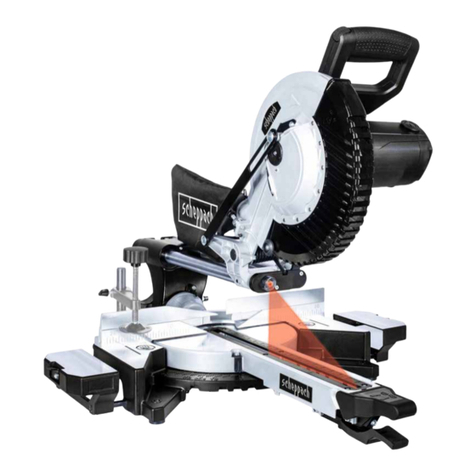
Scheppach
Scheppach MST254 Translation of original instruction manual
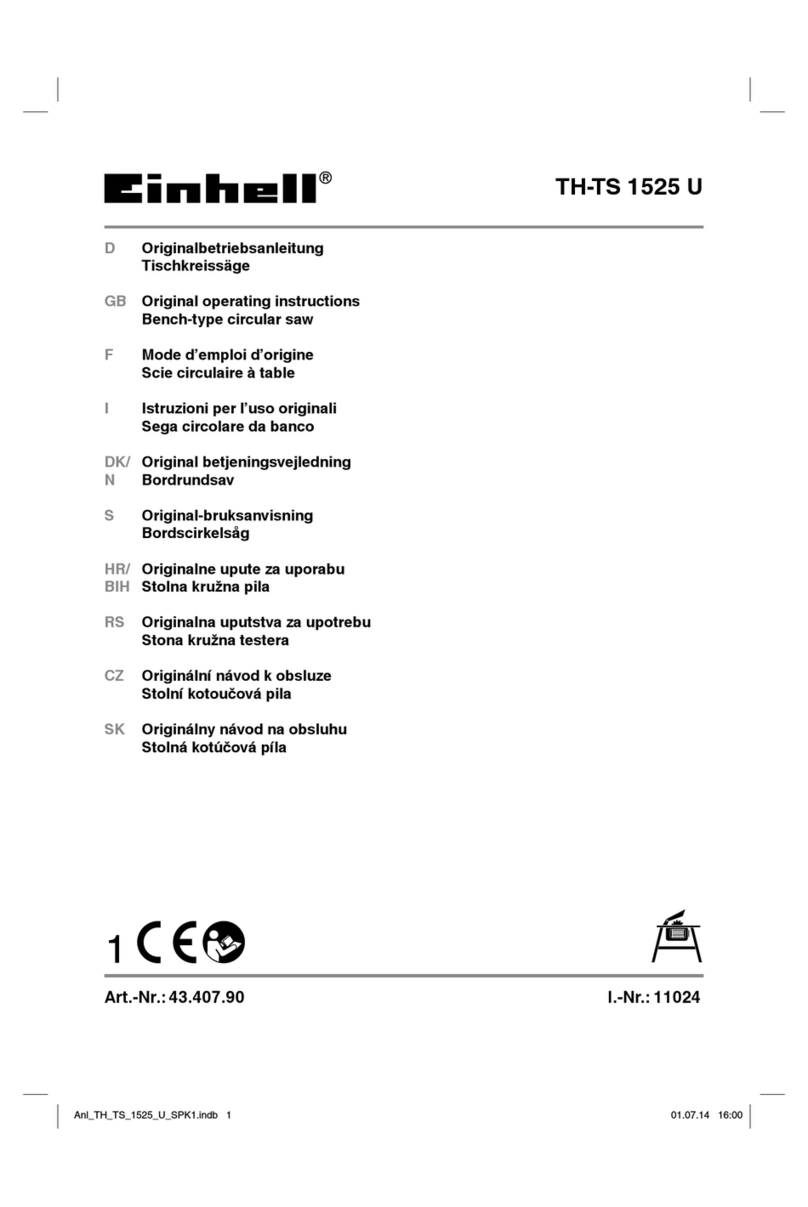
EINHELL
EINHELL TH-TS 1525 U Original operating instructions
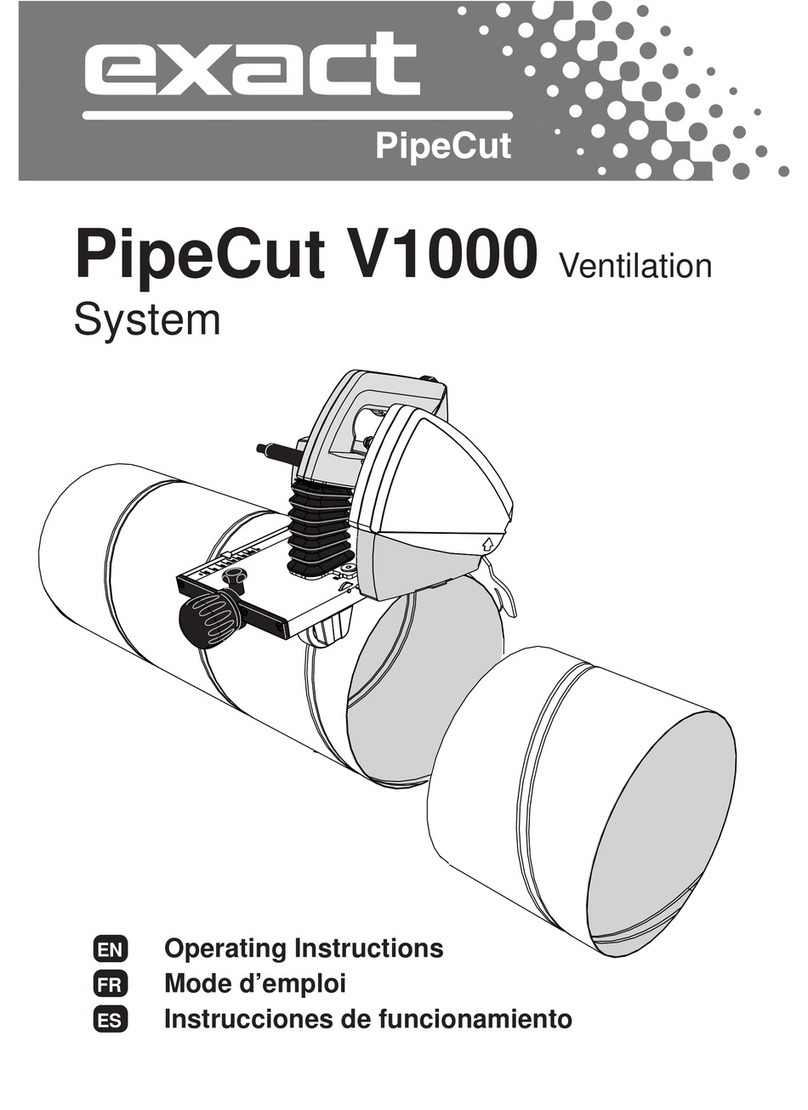
eXact
eXact PipeCut V1000 operating instructions
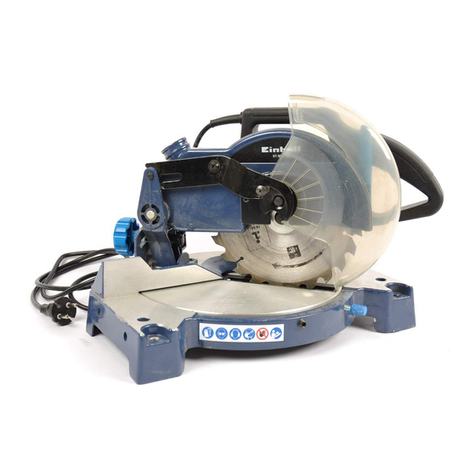
EINHELL
EINHELL BT-MS 210 operating instructions

WIDDER TOOLS
WIDDER TOOLS 10267 Product information and operating instructions
